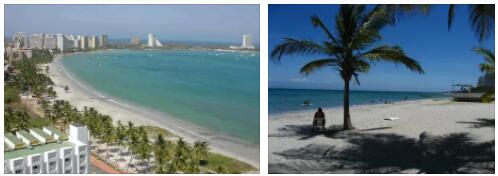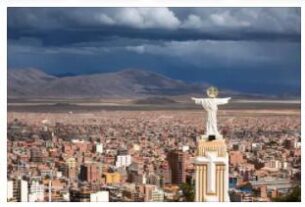Porlamar is the largest and most developed settlement of the island of Margarita. The city is located on its southeastern coast.
According to pharmacylib, Margarita Island is the largest island in Venezuela. Its area is about 1000 sq. km and it is located 38 km from the northwestern coast of the country. Margarita Island, together with the islands of Coche (Coche) and Cubagua (Cubagua) and reefs (there are about 70 of them) located just south, are combined into a separate state of Nueva Esparta (Nueva Esparta state). The Spaniards discovered the island in the 15th century. Pearls were mined in the waters surrounding it, and it immediately became an object of colonization. In recent years, pearl mining has ceased to be the main source of income on the island, now it is one of the most popular holiday destinations in Venezuela.. Margarita Island boasts 300 km of beaches. There are beaches for every taste: secluded and noisy with bars and restaurants, with waves and calm waters, surrounded by vegetation and deserted. You can get here by plane from Caracas or by ferry from the coastal cities of Puerto La Cruz and Cumana.
Margarita Island consists of two mountainous peninsulas – Macanao (in the west) and Paraguachoa (Paraguachoa) (in the east), connected by the isthmus of La Restinga. Most of the cities, beaches and infrastructure are located in the eastern part of the island.
In Porlamar, the complex of the seaport of Puerto de La Mar, a lighthouse, which was installed in 1891, a nearby monument to a mermaid that meets travelers at the entrance to the city, as well as one of the two casinos in Venezuela. The best beach in Porlamar is Playa La Caracola. In addition to the beaches surrounding Porlamar and the hotels, restaurants and nightclubs located here, the city is famous for its shops and large shopping centers. Since 1973, Margarita Island has had the status of a free trade zone, so in local shops you can buy clothes of famous brands, alcohol and other products at relatively low prices. The main shopping streets of the city are the boulevards of Santiago Marino, May 4th, Guevaro and Gomez. Santiago Marino International Airport is located
25 km from Porlamar. On the way to the airport outside the city is the Conejeros market. It sells a wide variety of goods – from clothes to souvenirs, and there is also a cafe where you can taste national cuisine. Playa El Yaque is located 5 km west of the airport.(Playa El Yaque). It is known all over the world because it has excellent conditions for kite and windsurfing. Most of the year in this part of the coast trade winds blow at a speed of 10 to 15 m/s. Maximum speeds are observed from January to May. Playa El Yaque is suitable for both experienced surfers and beginners, because the waters here are not deep. There are kitesurf stations on the beach, where instructors and equipment for rent are offered.
Northwest of Porlamar in the town of El Valle is the House Museum of Santiago de Marinho, the hero of the Venezuelan national liberation movement who was born here, and the church of the island’s patron saint. Nearby, on the slopes of the highest mountain range of the island, reaching a height of 960 m, lies the Cerro El Copey National Park. About 70 species of birds and 30 species of mammals live here among dry forests. Hiking tours through the forests are arranged in the park. Pampatar is located 10 km northeast of Porlamar on the east coast of Margarita Island. Pampatar is considered one of the oldest European settlements in Venezuela., it was founded in 1530. The main attraction of the city is the fortress of Castillo de San Carlos Borromeo, which stands in its very center on the coast. The fortress was built by the Spaniards in 1662, now it houses the Historical Museum. Also in Pampatar there are many large shopping centers and the island’s largest nightclub – Kamy Beach. The best beaches are located north of Pampatar along the entire east coast of Margarita Island. The nearest beach to the city is Playa Guacuco, followed by the beaches of Playa El Tirano, Playa Parguito and Playa Agua (Playa Agua). All the beaches of the east coast, which is washed by the waters of the Atlantic Ocean, are a favorite vacation spot for surfers, because waves suitable for surfing are constantly observed here. Among the beaches listed above, Playa Agua stands out. Perhaps this is the most popular place to stay on the island. Its length is 4 km, and its width is 30 m. Along the entire beach, in the shade of trees, there is a boulevard with restaurants, cafes, bars and shops. At Playa Agua, horseback riding is offered to tourists.
In the vicinity of Playa Agua there is an Aquapark area of 45 thousand square meters. m. The park has 4 slides, including an 18-meter slide, nicknamed “Angel Falls” for its height, an artificial river flowing through the entire park, along which you can swim along with the flow on air mattresses, a children’s mini-park, showers, cabanas and small cafes. Sightseeing boats depart from Playa El Tirano to the south for snorkeling trips to the Los Frailes Islands.
The capital of the state of Nueva Esparta – the city of La Asunción – is located far from the coast north of Porlamar. Here it is worth visiting the Santa Rosa fortress of the late 16th century, the Nueva Cadiz Museum, which exhibits works by Venezuelan artists and sculptors, the church of La Iglesia de Nuestra Señora de La Asunción from the 16th and 17th centuries and the monastery of San Francisco 16 century, where the state administration is now located. In the vicinity of La Asuncion, the Tropical Plant Park is interesting. Juan Griego is the main city on the north coast of Margarita Island. Among the sights of the city stand out the ancient fort La Galera, which divides the city bay into two parts, and Calle La Marina street with shops. The beaches of this coast of the island are characterized by calm waters and are suitable for families with children. The closest beaches to Juan Griego are Playa Caribe and Playa La Galera, further east stretch the beaches of Playa Zaragosa, Playa Puerto Cruz and Playa Manzanillo.
In the center of Margarita Island, on the isthmus of La Restinga, which connects its western and eastern parts – the Macanao and Paraguachoa peninsulas – is the La Restinga Bay National Park (Laguna de La Restinga National Park). La Restinga Bay is a vast lagoon with many islets and channels and mangroves. There are about 100 species of birds, several species of turtles and 30 species of mammals in the park, including two endemics – the forest rabbit and the white-tailed deer. Tours here take place on boats from 7 am to 5 pm. All excursions end on a picturesque beach with a length of 22 km, where you can sunbathe and swim.
In the western part of Margarita Island – on the Macanao Peninsula – there are few beaches, and fishing villages are located along the coast. Here are the beaches of Playa La Pared and Playa Punta Arenas. (Playa Punta Arenas). There are few tourists and almost no vegetation. Of the interesting places of the peninsula, the Maritime Museum in the town of Boca de Rio stands out with the skeleton of a giant whale, exhibition halls dedicated to marine life, pearls and fishing boats, an aquarium with a variety of marine animals, and copies of the original view of some cities of Margarita Island that were destroyed by pirates. Also on the peninsula it is proposed to go on a horseback ride.
South of Margarita Island are the islands of Coche and Cubagua.. The area of Koche Island is 55 sq. km, and Cubagua – only 22 sq. km. Infrastructure is not developed on the island of Cubagua, several fishing families live here. The island’s only city, Nueva Cadiz, was destroyed by a tropical cyclone back in the 16th century. But the island of Coche is known for its Playa La Punta beach, where kite surfers relax.



